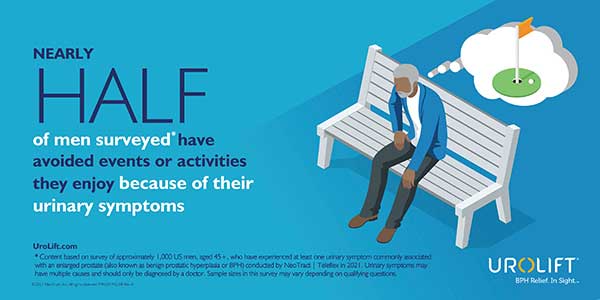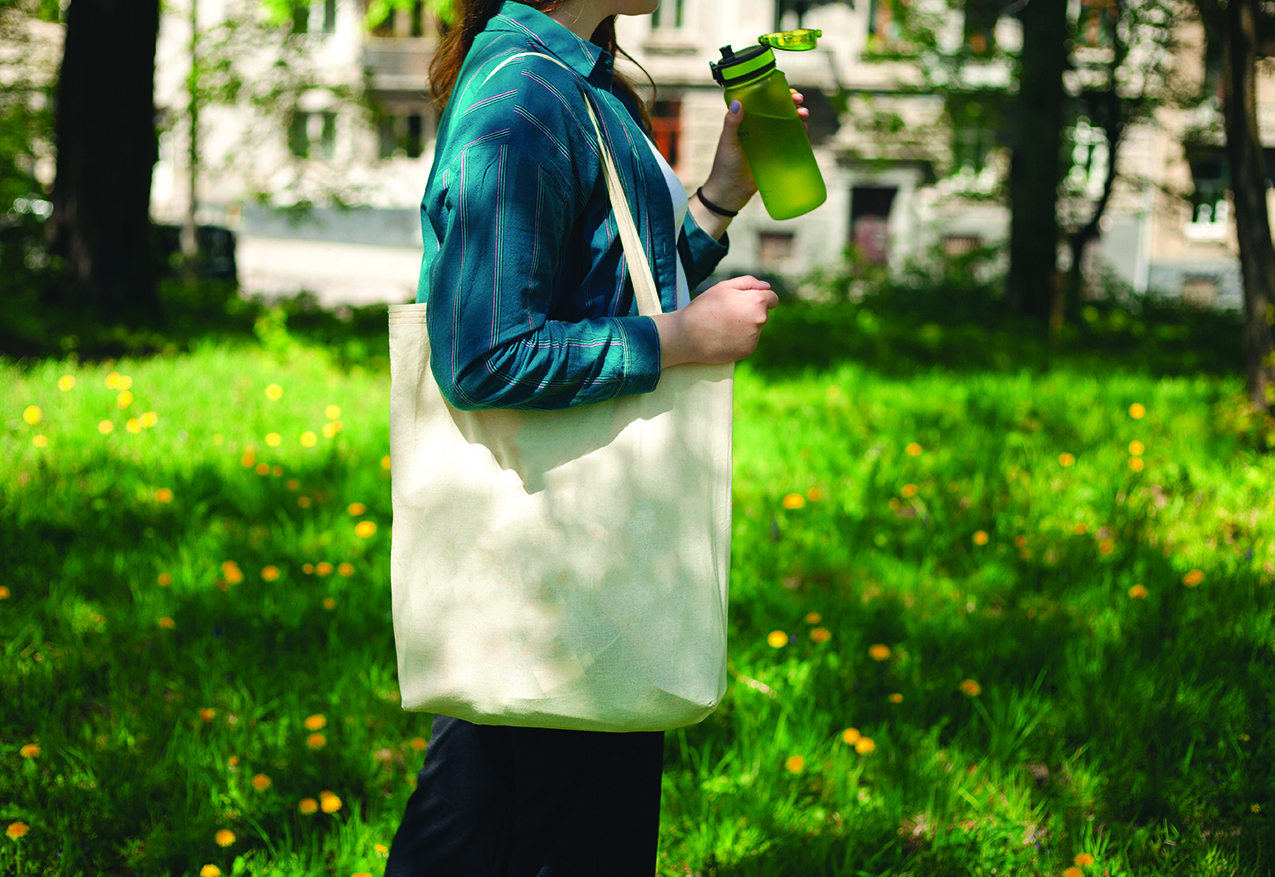HEALTHY LIVING
How urinary symptoms may lead men to avoid activities

(Family Features) Men with urinary symptoms common with an enlarged prostate, also known as benign prostatic hyperplasia or BPH, may anticipate and plan for urgent and frequent bathroom needs and even avoid events and activities they enjoy because of their urinary symptoms. Whether they rearrange their morning schedules in anticipation of interrupted sleep, limit the amount they drink or purposefully seek out and stay close to the bathroom, this is known as extreme bathroom planning and can disrupt normal daily activities.
 In men with BPH, the enlarged prostate presses on and blocks the urethra, causing bothersome urinary symptoms, such as an urgent or frequent need to urinate or the sensation that the bladder is not empty after urinating. These symptoms can significantly impact a man’s quality of life, leading to interrupted sleep and even a loss of productivity and depression, according to research published in “British Journal of Urology International.”1
In men with BPH, the enlarged prostate presses on and blocks the urethra, causing bothersome urinary symptoms, such as an urgent or frequent need to urinate or the sensation that the bladder is not empty after urinating. These symptoms can significantly impact a man’s quality of life, leading to interrupted sleep and even a loss of productivity and depression, according to research published in “British Journal of Urology International.”1
As part of a survey sponsored by Teleflex Incorporated of approximately 1,000 men in the United States, 45 years and older, who have experienced at least one bothersome urinary symptom, nearly half (45.49%) reported they have avoided events or activities they enjoy because of their bothersome urinary symptom.2
When they do attend an event or perform an activity, a significant number of men surveyed make plans or take action to accommodate their bathroom needs. In fact, more than 40% have chosen certain routes on road trips because they have more or better availability of restroom facilities. Additionally, about 1 in 5 said locating the closest bathroom is the first thing they do when they go somewhere new, and about 43% selected seats when purchasing tickets to an event based on proximity to the restroom.2
These “extreme” bathroom planning habits are not just limited to daytime activities. Many men with urinary problems, including BPH patients, experience frequent nighttime waking to urinate.
The majority of those surveyed (more than 70%) said their energy levels have been impacted during the day because they get up frequently at night to urinate. To avoid this, about 3 in 4 men (74.8%) limit the amount they drink in the evening. Some men (about 22%) have even slept in another bed or room than their spouse, partner or significant other to avoid waking him or her when getting up to urinate.2
 “It’s important for men to be aware of symptoms of BPH, including frequent trips to the bathroom during both daytime and nighttime,” said Ana Fadich, vice president of the nonprofit Men’s Health Network. “While not all urinary symptoms are caused by BPH, men over the age of 45 who are experiencing urgent or frequent urinary symptoms should consider speaking with their doctor about their prostate health.”
“It’s important for men to be aware of symptoms of BPH, including frequent trips to the bathroom during both daytime and nighttime,” said Ana Fadich, vice president of the nonprofit Men’s Health Network. “While not all urinary symptoms are caused by BPH, men over the age of 45 who are experiencing urgent or frequent urinary symptoms should consider speaking with their doctor about their prostate health.”
More than 12 million men in the U.S. seek treatment for BPH.3 BPH is unrelated to, but more common than, prostate cancer, according to the American Cancer Society,4,5 and if left untreated can lead to permanent bladder damage.6
Medications are a common treatment option for men diagnosed with BPH. Among those surveyed, more than 65% have taken medication to treat their condition. However, nearly 1 in 4 said their medication was “not very effective” or “not effective at all” at helping reduce their need to plan their next bathroom trip.2
BPH relief through medication can be inadequate with potential side effects such as sexual dysfunction, dizziness and headaches, prompting many men to quit using their BPH treatment medications.7 A study published in the “Journal of Urology” also found commonly prescribed BPH medications are linked to an increased risk of new instances of heart failure in some men.8 Among men participating in the Teleflex survey, those men taking BPH medication and who have never had a medical procedure or surgery to treat their condition, more than two-thirds (66.81%) said they are extremely, very or somewhat interested in a minimally invasive procedure that could help reduce their bathroom visits and planning needs.2
An option like the UroLift® System is a minimally invasive treatment for lower urinary tract symptoms due to BPH. It is indicated for the treatment of symptoms of an enlarged prostate up to 100 cubic centimeters in men 45 years or older. The UroLift System permanent implants, in many cases can be delivered during an outpatient procedure and is a proved approach to treating prostate obstruction without heating, cutting, destroying or removing prostate tissue.9,12
The UroLift System is the only leading BPH procedure shown to not cause sexual dysfunction (no instances of new, sustained erectile or ejaculatory dysfunction) as shown in the LIFT pivotal study.10,11 Most common side effects are temporary and include pain or burning with urination, blood in the urine, pelvic pain, urgent need to urinate and/or the inability to control the urge.9 Rare side effects, including bleeding and infection, may lead to a serious outcome and may require intervention. Speak with your doctor to determine if you may be a candidate.
To talk to a doctor about safe and effective treatments for BPH, visit UroLift.com to find a urologist in your area.
1. Speakman, BJUI 2014
2. Data on file: Men’s Health Survey 2021, n=1,000 conducted by Teleflex l NeoTract 2021
3. NeoTract US Market Model estimates for 2020, data on file
4. American Cancer Society Key Statistics for Prostate Cancer http://www.cancer.org/cancer/prostatecancer/detailedguide/prostate-cancer-key-statistics
5. Berry, J Urol 1984
6. Tubaro, Drugs Aging 2003
7. AUA BPH Guidelines 2003, 2010, 2018
8. Lusty A, J Urol 2021
9. Roehrborn, J Urology 2013 LIFT Study
10. AUA BPH Guidelines 2003, 2020
HEALTHY LIVING
How to conduct a skin care self-exam

Time spent soaking up the summer sun is one of the things that makes the season so appealing. Warm outdoor air has a calming effect that can make anyone feel more relaxed and comfortable.
As good as warm summer sun can feel, overexposure to the sun can be dangerous. The World Cancer Research Fund reports there were more than 330,000 new cases of skin cancer diagnosed across the globe in 2022. A significant percentage of skin cancer cases can be prevented, and prevention is a multifaceted process that includes skin care self-examinations. Self-exams do not take up much time, and individuals can speak with their physicians about how frequently they should check their skin for signs of skin cancer. The U.S. National Library of Medicine offers the following instructions for how to conduct a skin self-exam.
Choose the right time to examine your skin. The USNLM recommends conducting a skin exam after bathing. Women who routinely conduct breast self-exams can check their skin at this time as well.
Use a full-length mirror. ItÕs not always easy to examine skin throughout the body. But signs of skin problems can occur anywhere on the body, including areas that might be hard to see without help. If possible, conduct a self-exam of the skin in front of full-length mirror in a brightly lit room.
Identify what youÕre looking for. The USNLM notes you should be looking for any new skin markings. This includes bumps, moles, blemishes, and changes in skin color.
Pay close attention to preexisting moles. A potential sign of skin cancer includes moles that change over time. Examine preexisting moles to see if they have changed in size, texture, color, and shape.
Look for unusual moles. The USNLM characterizes certain moles as Òugly duckling moles.Ó These unique moles look and feel different from nearby moles and may be indicative of skin cancer. Speak with a dermatologist if a self-exam uncovers the presence of moles with uneven edges or differences in colors or asymmetric shapes. Moles that look different from one side to the other also should be brought to the attention of a dermatologist. Moles that do not stop bleeding or will not heal also merit examination by a skin care professional.
When the time comes to conduct the exam, the USNLM recommends following these steps:
- Look closely at your entire body, both front and back, in the mirror.
- Check under your arms and on both sides of each arm. Be sure to examine the backs of your upper arms, which can be hard to see.
- Bend your arms at the elbow, and examine both sides of your forearm.
- Examine the tops and palms of your hands.
- Examine the front and back of both legs.
- Examine your buttocks and between your buttocks.
- Examine your genital area.
- Examine your face, neck, the back of your neck, and scalp. Use both a hand mirror and full-length mirror, along with a comb, to see areas of your scalp.
- Examine your feet, including the soles and the spaces between your toes.
- Ask a person you trust to help examine hard-to-see areas.
Skin cancer poses a formidable threat, but many cases of the disease are preventable. Routine skin self-exams are a vital component of skin cancer prevention. TF256909
HEALTHY LIVING
What does 100% grass-fed organic dairy bring to your table

(Family Features) It’s no secret that many grocery store dairy sections are filled with more options today. One choice continuing to gain favor with consumers is 100% grass-fed organic dairy. Nutrition, environmental awareness and animal care are some of the leading reasons consumers choose grass-fed dairy products.
Globally, the 100% grass-fed dairy market is projected to continue growing and some market experts predict annual growth rates as high as 22%. If you’re curious about 100% grass-fed organic dairy, consider these benefits from Maple Hill, America’s original 100% grass-fed organic dairy producer. The pioneer of 100% grass-fed organic dairy took its commitment a step further by celebrating and declaring National 100% Grass-Fed Organic Dairy Day on April 15, which recognizes the positive impact it has on consumers, cows, farmers and the environment.
1. Honoring the Farmers
Unlike large-scale corporate dairy farms, most organic farms are small, family-owned operations dedicated to traditional, sustainable farming. Small dairy farms have been disappearing, but 100% grass-fed organic dairy creates a sustainable, viable path forward for farmers who work in harmony with nature.
This more natural approach to dairy is a “craft” process favoring small family farmers who are willing to dedicate the extra focus and patience to a better product and process. These family farms are passed on to future generations to grow the “better for you, better for the planet” approach.
2. Commitment to Good Health
Most consumers don’t know the difference between traditional organic and 100% grass-fed organic dairy. One key distinction is the products’ nutritional composition; 100% grass-fed organic dairy provides a 50% healthier ratio of omega 3:6 and 40% higher levels of CLA fatty acids, which may support heart health and provide other health benefits.
What’s more, Maple Hill’s products made with 100% grass-fed organic dairy are GMO free, hormone free and antibiotic free with no additives or fillers. The line of high-quality, rich-flavored products let you experience the organic difference from traditional dairy for a nutrient-dense solution that tastes as nature intended.
3. Happy, Healthy Cows
Cows on a 100% grass-fed diet can live up to three times as long as grain-fed cows and are never subjected to unnatural diets, hormones or antibiotics. More time in pastures filled with lush grass means cows have the freedom to roam, ruminate and graze on diverse, nutrient-rich grasses.
The result is happier, healthier cows, which in turn results in a richer, better-tasting and more nutrient-dense milk.
4. Sustainability and the Environment
Producing milk without grain or corn requires farmers to focus on regenerating soil and the soil life that supports everything else on the farm. In fact, the healthier the soil, the healthier the feed, so farmers have a natural incentive to be as regenerative as possible. Regenerative grazing practices are a powerful and positive tool to improve land and the web of life on farms by actively restoring soil health, promoting biodiversity and reducing the environmental impact compared to conventional dairy.
Well-managed grazing helps pull carbon from the atmosphere into the soil, fighting climate change in the process. In addition, healthier soil retains more water, reducing runoff and protecting water sources from agricultural pollution.
5. Strengthening the 100% Grass-Fed Organic Market
Consumers are increasingly aware of the choices they have in dairy products and how 100% grass-fed organic supports their health, farmers, animals and the planet. Some ways to support this category’s continued growth include choosing certified 100% grass-fed organic dairy, advocating for regenerative farming and helping shape a more sustainable food system.
Learn more about 100% grass-fed organic dairy products at maplehill.com.
SOURCE:
HEALTHY LIVING
Promote health with these daily habits

Health should be a priority, but too often life gets in the way and individuals take a reactive, rather than proactive, approach to their personal well-being. But living healthier need not be so difficult. In fact, research suggests that small, positive changes in how a person lives each day creates a healthier person over time.
A Hologic-Gallup survey on the state of women’s health conducted in April 2024 found 63 percent of respondents said it was hard for them to make health a priority. They cited feeling overwhelmed, needing to care for others before themselves, emotional/mental health, and work as the top barriers to focusing on health. But it’s important that both women and men recognize that small changes can add up to big results. These healthy habits can help individuals start living healthier lifestyles.
· Get some exercise. Regular physical activity is one of the most important things a person can do fo his or her health. Exercise helps manage weight, reduces the risk of disease, strengthens bones and muscles, and improves brain health. The Centers for Disease Control and Prevention says adults should aim for at least 150 minutes (30 minutes a day for five days) of moderate-intensity aerobic activity a week. A great place to begin is with a daily walk, which is a simple and effective habit that does not require a lot of time and no equipment except a good pair of athletic shoes.
· Wear sunscreen every day. After washing your face each morning, apply a facial moisturizer with an SPF of at least 30, or blend equal parts of sunscreen and regular moisturizer, suggests Harvard Health. Use it on the face, neck, ears, and any thinning hair spots on the scalp. Skin cancer is the most common type of the disease worldwide, and wearing sunscreen can help many people avoid it.
· Spend time outdoors. It takes just a few minutes in the sun to raise vitamin D levels. Vitamin D is necessary for bone and heart health and helps to boost mood, says WebMD. Various studies indicate spending time in green spaces promotes calm and increases happiness.
· Plan your meals. Meal planning is not just a way to manage food budgets. It’s also a great method to being more mindful of food choices and avoiding impulse buys or meals that may not be as healthy as they can be. Adding more plant-based foods to a diet is a good start. Such foods can reduce the risk of chronic conditions like high cholesterol and hypertension.
· Stay hydrated. Hydration supports good digestion, increases energy and may improve brain performance, states Harvard Health. Drink a glass of water each day upon waking up and with every meal. Older adults often do not feel thirst like they did when they were younger, so it is especially important for seniors to stay hydrated.
Healthy habits are more easily adopted when people begin small and make a daily commitment to their overall health.
-

 NEWS2 years ago
NEWS2 years ago2 hurt, 1 jailed after shooting incident north of Nocona
-

 NEWS2 years ago
NEWS2 years agoSuspect indicted, jailed in Tia Hutson murder
-

 NEWS2 years ago
NEWS2 years agoSO investigating possible murder/suicide
-

 NEWS2 years ago
NEWS2 years agoWreck takes the life of BHS teen, 16
-

 NEWS2 years ago
NEWS2 years agoMurder unsolved – 1 year later Tia Hutson’s family angry, frustrated with no arrest
-

 NEWS2 years ago
NEWS2 years agoSheriff’s office called out to infant’s death
-

 NEWS2 years ago
NEWS2 years agoBowie Police face three-hour standoff after possible domestic fight
-

 NEWS2 years ago
NEWS2 years agoDriver stopped by a man running into the street, robbed at knifepoint






